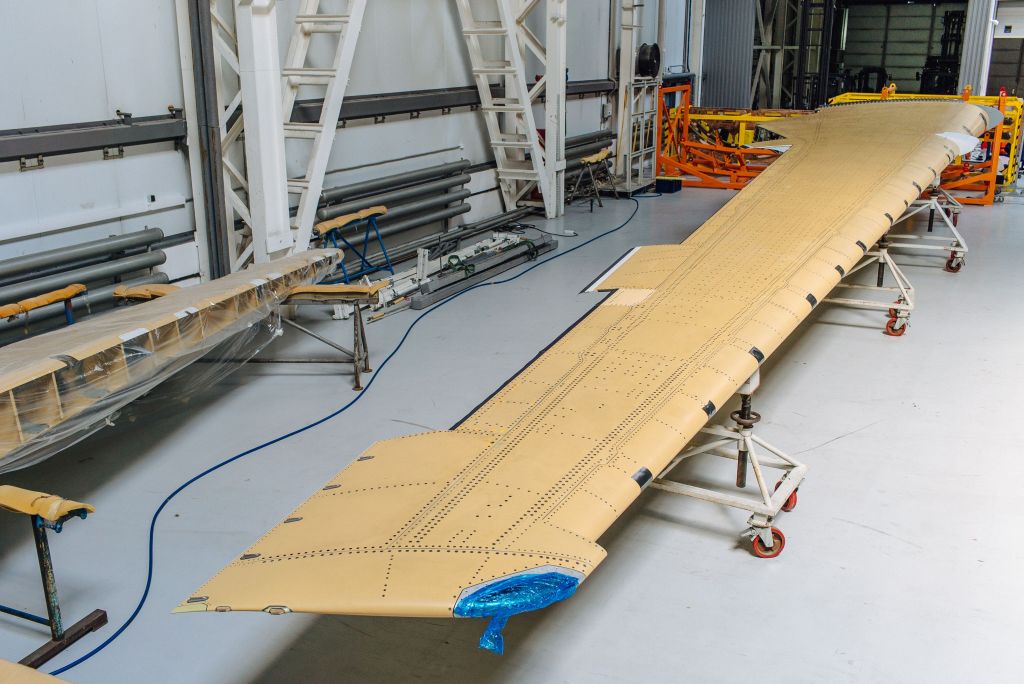
information items property 3258
There was not a word about it in the press release, but the announcement that Irkut Corporation has taken delivery of the first MC-21 wing made from Russian composites has everything to do with the current political climate in which Russia finds itself. That Irkut has been forced to source homemade composites in the first place is a direct consequence of US and EU sanctions on Russia since 2014. These sanctions have actually helped Irkut.
When United Aircraft Corporation (UAC) launched the Irkut MC-21 in 2008 as the Russian answer to the Airbus A320neo and Boeing 737 MAX, it had in mind collaborating with a range of international partners. The MC-21 website, not updated for a long time, still confirms some Western partners for the program. As material suppliers, it mentions AkzoNobel, PPG Aerospace, and two specialized in composites: Connecticut-based Hexcel Composites and New Jersey-based Cytec. The latter has been absorbed by Solvay back in July 2015 and is now Cytec Solvay Group.
Wing produced by out-of-autoclave technology
Both have played an instrumental role in what can be regarded as a masterpiece in the technology of the MC-21: the composite wings made through resin infusion. Where composite structures on aircraft are usually made layer by layer and then baked under high pressure and temperatures inside an autoclave, Irkut uses out-of-autoclave technology. A polymer resin is put inside a vacuum mold and ‘dried’ under atmospheric pressure outside an autoclave. This results in an extremely strong and durable product that allowed the Irkut engineers to design a very slender, light, and effective wing with a high aspect ratio.
Mastering this technology has taken a few years. When UAC and Sukhoi formed a new dedicated company, JSC AeroKompozit, in Ulyanovsk back in 2008, their learning curve brought them to Austria in 2010. To Wiener Neustadt to be exact, the home of small airplane maker Diamond Aircraft. They produced four MC-21 wings commissioned to them that were produced together with Premium AEROTEC, the German aerostructure specialist that will soon become an integral part of Airbus. Vacuum resin infusion technology is used on the MC-21’s wings, wing box, spars, stringers, and skin, or thirty percent of the aircraft’s structure. All MC-21 prototypes have been made using this technology in the AeroKompozit plant.
UAC and Irkut on Trump’s sanctions list
But the import of Western-produced resin has stopped since the US and European Union imposed economic and political sanctions on Russia since 2014, first in response to the annexation of Crimea and later to the war in Eastern Ukraine, resulting in the tragic downing of Malaysian Airlines flight MH17. While the US initially sanctioned only UAC’s defense activities, the Trump government expanded these to include Russia’s civil aerospace programs like the MC-21. Later, he backtracked and allowed Pratt & Whitney to continue the supply of its PW1400G-JM engines, but since then the Russians have been pushing to have their home-made AviaDvigatel PD-14 ready as soon as possible. On the Haxcel website, you are looking in vain for anything on the Irkut.
Prototype MSN006 showing the slender and efficient wings of the MC-21. (Irkut)
Without the supplies from Hexcel and Cytec Solvay to count on, UAC has been forced to develop its own resin and composites to produce the necessary parts for the Irkut airliner. This involved close cooperation with leading Russian chemists and technologists, including experts and academics from Moscow State University and Rosatom. Together, they developed and produced the domestic composite. Back in 2019, the nuclear agency Rosatom performed numerous trials on the product to test its integrity.
Having earlier shipped the first MC-21 wing box that is produced with the same technology, Irkut reported on May 14 that the first 17.5 meters long all-Russian composite wing had been shipped to Irkutsk. By road, from the AeroComposite plant in Ulyanovsk all the way East on a trip almost 4.000 kilometers long. The wing was loaded on a dedicated truck and platform to prevent any structural damage during the trip. Irkut is clearly lacking the option of using Beluga or Dreamlifter equipment, although an Antonov An-124 could easily do the job.
Russians have mastered Western technology
How US sanctions have helped Irkut? The delivery of the first wing is a major milestone for Russia’s aerospace industry. It is proof that it has become self-supplying and has mastered technologies that were seen exclusive to the Western industry until now. The international sanctions have forced UAC to accelerate the development of its technical capabilities that will benefit not just the MC-21 but also future programs like the Sino-Russian CR929 widebody and other aircraft. It is exactly what the Russians wanted when they defined the MC-21 some fifteen years ago and dictated that it would have to deliver a huge step in technology. Next on the MC-21 will be the development of Russian-made avionics.
If the sanctions have really hurt the schedule of the MC-21 program is difficult to judge. After the first flight of prototype 001 in May 2017, Irkut has taken a step-by-step approach to bring four test aircraft into service. Production of the first customer aircraft MSN21007 has been underway for some time, as an Irkut spokesperson told Airinsight last year. That its first wing has only arrived recently could be an indication that there has been a delay indeed, but the program is already over two years behind schedule. The MC-21 was supposed to enter service in 2019 but it still needs to receive type certification. Last year, the plan was for a late 2021/early 2022 entry into service with Aeroflot – powered by P&W Geared Turbofans.
Views: 11




